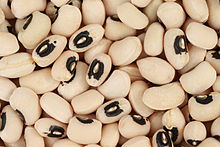Cowpea
| Cowpea | ||||||||||||
|---|---|---|---|---|---|---|---|---|---|---|---|---|

Cowpea ( Vigna unguiculata subsp. Unguiculata ) |
||||||||||||
| Systematics | ||||||||||||
|
||||||||||||
| Scientific name | ||||||||||||
| Vigna unguiculata | ||||||||||||
| ( L. ) Walp. |
The cowpea ( Vigna unguiculata ), and cowpea , black-eyed pea or snake bean called, is a useful plant from the family of legumes (Fabaceae). Four subspecies are recognized:
- Vigna unguiculata subsp. dekindtiana , the wild form related to useful plants
- Vigna unguiculata subsp. unguiculata , cultivated, this article (Engl. black-eyed pea)
- Vigna unguiculata subsp. cylindrica , cultivated, Catjang bean
- Vigna unguiculata subsp. sesquipedalis , cultivated, asparagus bean
features
The cowpea is an annual plant . Their habitus is quite variable and ranges from upright to semi-upright to prostrate to climbing. The growth type ranges from undetermined to determined, with the non-climbing forms in particular showing determined growth. They have a distinctive taproot that can reach 2.4 m deep 8 weeks after sowing.
The leaves are in three parts. They are smooth, blunt to shiny and rarely hairy. The terminal leaflet is often longer and larger than the two lateral ones. Leaf size and shape are very variable. From noon onwards, the leaves align themselves parallel to the incident solar radiation and thus escape most of the incident radiation intensity .
The flowers are in multiple panicles on 20 to 50 cm long inflorescence stalks that arise in the leaf axils. Two to three pods are formed per inflorescence , and there are also four or more. The flowers stand well above the leaves and also contain nectaries to attract insects. Nevertheless, self-pollination prevails .
The pods are smooth and 15 to 25 cm long. They are cylindrical and slightly curved. When ripe for use as a vegetable, the pods are green, yellow or purple; when ripe for dryness, the green and yellow forms turn brown. The seeds are kidney-shaped. The seed surface is smooth or wrinkled, the color can be white, cream, green, red, brown or black. Often they have an “eye”, that is, the white navel ( hilum ) is outlined in a different color.
The chromosome number is 2n = 22 for the subspecies Vigna unguiculata subsp. unguiculata , Vigna unguiculata subsp. cylindrica and Vigna unguiculata subsp. sesquipedalis .
ingredients
100 g of mature seeds contain an average of 24.8 g of protein , 1.9 g of fat, 6.3 g of fiber and 63.6 g of carbohydrates . The vitamins contain 0.74 mg thiamine , 0.42 mg riboflavin and 2.8 mg niacin . The protein is relatively rich in the amino acids lysine and tryptophan , but relatively poor in methionine and cystine .
Cultivation
The cowpea is native to Africa. Today it is grown in Africa, Latin America, Southeast Asia and the southern United States. Cultivation in West Africa dates back at least 4000 years.
It is mainly grown in the humid tropics, but also in temperate areas. Heat and drought are tolerated well, frost is not tolerated, cool temperatures significantly slow down growth. The yield increases significantly with the water supply, such as irrigation. Even under dry conditions, the cowpea still provides good yields, which is why it is so important in many areas.
The cowpea does not make any special demands on the soil; it thrives best on well-drained sandy to sandy-loamy soils with pH values between 5.5 and 6.5.
use
The cowpea is used as a vegetable in all growth stages. Like spinach, young green leaves are prepared as leafy vegetables in Africa . Immature pods are also prepared as vegetables. Green seeds are used cooked as fresh vegetables, canned or frozen. Ripe, dry seeds are boiled or preserved. The seeds can germinate and, like mung bean sprouts, can be eaten raw.
The leaves are fed to livestock and are often the only high quality animal feed available. In terms of quality, it is on par with alfalfa . It is fed fresh or dry.
In the Bahian kitchen , the black eyes of the bean are removed, the skin of the bean is peeled off, ground and processed into acarajé .
Systematics
Within the species Vigna unguiculata , a distinction is made between three taxa , which are classified either as subspecies or as groups of varieties:
- Cowpea: Vigna unguiculata subsp. unguiculata or Vigna unguiculata variety group 'Unguiculata'
- Catjang bean : Vigna unguiculata subsp. catjang or Vigna unguiculata subsp. cylindrica (L.) Verdc. or Vigna unguiculata variety group 'Biflora'
- Asparagus bean : Vigna unguiculata subsp. sesquipedalis or Vigna unguiculata variety group 'Sesquipedalis'
Rosh Hashanah Seder
The cowpea is called Rubiya (Arabic: lubiya ) in Hebrew and, like honey and apple, is part of the Seder for Rosh Hashanah , the Jewish New Year.
supporting documents
- DW Davis, EA Oelke, ES Oplinger, JD Doll, CV Hanson, DH Putnam: Cowpea , in: Alternative Field Crops Manual , University of Wisconsin Cooperative or Extension Service, 1991. Retrieved July 18, 2009.
Individual evidence
- ^ KA Schakel, AE Hall: Reversible Leaflet Movements in Relation to Drought Adaptation of Cowpeas, Vigna unguiculata (L.) Walp . In: Functional Plant Biology . tape 6 , no. 3 , 1979, ISSN 1445-4416 , pp. 265-276 , doi : 10.1071 / pp9790265 ( csiro.au [accessed November 4, 2017]).
- ↑ Vigna unguiculata at Tropicos.org. In: IPCN Chromosome Reports . Missouri Botanical Garden, St. Louis
- ^ Richard L. Fery: New Opportunities in Vigna . In: J. Janick, A. Whipkey (Ed.): Trends in new crops and new uses . ASHS Press, Alexandria, VA, 2002, pp. 424-428, (pdf; 26 kB) .
Web links
- Vigna unguiculata . In: U. Brunken, M. Schmidt, S. Dressler, T. Janssen, A. Thiombiano, G. Zizka: West African plants - A Photo Guide. Senckenberg Research Institute, Frankfurt am Main 2008.

